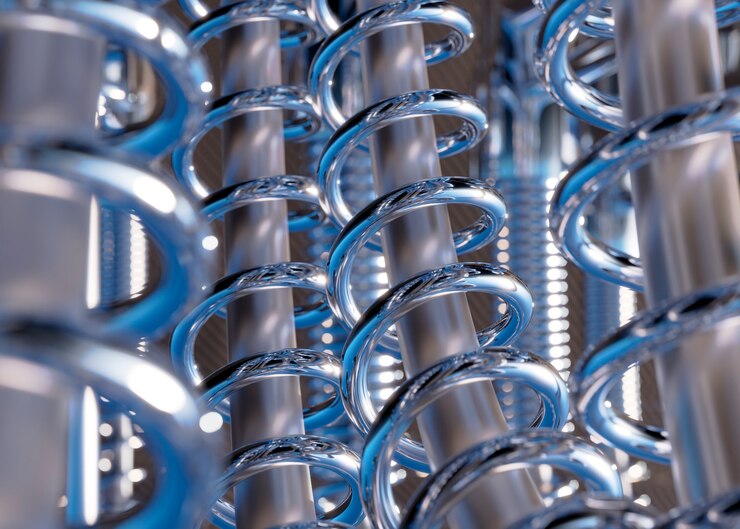When it comes to engineering, construction, or manufacturing, the choice of materials can significantly impact the performance and longevity of a product. Among the myriad of options available, stainless spring steel strip stands out for its remarkable combination of strength, durability, and flexibility. In this blog post, we’ll delve into the characteristics and applications of stainless spring steel strip, exploring why it’s a preferred choice in various industries.
What is Stainless Spring Steel Strip?
Stainless spring steel strip is a type of steel alloy renowned for its corrosion resistance, high tensile strength, and ability to return to its original shape after being bent, twisted, or stretched. It owes its unique properties to its composition, typically consisting of iron, chromium, nickel, and other elements in varying proportions. The addition of chromium enhances its corrosion resistance, making it suitable for applications where exposure to moisture or harsh environments is a concern.
Characteristics of Stainless Spring Steel Strip
- Corrosion Resistance: One of the most significant advantages of stainless spring steel strip is its resistance to corrosion. This makes it ideal for use in outdoor or marine environments where exposure to moisture, saltwater, or chemicals could degrade other materials.
- High Tensile Strength: Stainless spring steel strip boasts impressive tensile strength, allowing it to withstand high levels of stress without deforming or breaking. This characteristic makes it suitable for applications that require components to withstand heavy loads or repetitive motion.
- Flexibility and Elasticity: Despite its strength, stainless spring steel strip remains highly flexible and elastic. It can be bent, twisted, or compressed repeatedly without losing its shape or mechanical properties. This resilience is crucial in applications where constant movement or vibration is expected.
- Heat Resistance: Stainless spring steel strip exhibits good heat resistance, retaining its strength and integrity even at elevated temperatures. This property makes it suitable for applications where exposure to high temperatures is unavoidable, such as automotive exhaust systems or industrial furnaces.
- Magnetic Properties: Depending on its composition, stainless spring steel strip may exhibit magnetic properties, making it suitable for use in applications where magnetic attraction is desired, such as magnetic resonance imaging (MRI) machines or magnetic closures.
Applications of Stainless Spring Steel Strip
- Automotive Industry: Stainless spring steel strip finds widespread use in the automotive industry for manufacturing various components, including springs, fasteners, clips, and suspension systems. Its combination of strength, corrosion resistance, and elasticity makes it well-suited for these demanding applications.
- Aerospace Sector: In the aerospace sector, where lightweight yet durable materials are essential, stainless spring steel strip is used in the fabrication of aircraft components, including landing gear, engine mounts, and structural reinforcements. Its high strength-to-weight ratio and resistance to fatigue make it a preferred choice for critical aerospace applications.
- Medical Devices: Stainless spring steel strip is also utilized in the manufacture of medical devices and equipment, such as surgical instruments, orthopedic implants, and medical springs. Its biocompatibility, corrosion resistance, and ability to withstand sterilization processes make it suitable for use in healthcare settings.
- Consumer Electronics: Many consumer electronic devices, including smartphones, laptops, and wearables, incorporate stainless spring steel strip in their construction. It is used for components such as battery contacts, connectors, and hinges, where its combination of strength and flexibility is essential for reliable performance.
- Industrial Machinery: In industrial machinery and equipment, stainless spring steel strip is employed in various applications, including conveyor systems, stamping dies, and machine components. Its durability, resistance to corrosion, and ability to withstand heavy loads make it a valuable material in industrial settings.
High Strength Carbon Steel Plate: A Foundation for Structural Excellence
In the realm of construction and heavy engineering, the choice of structural material is paramount to ensuring the safety, stability, and longevity of buildings, bridges, and infrastructure. High strength carbon steel plate, renowned for its exceptional strength-to-weight ratio and durability, serves as a cornerstone in the construction of robust and resilient structures. In this section, we’ll explore the characteristics and applications of high strength carbon steel plate, shedding light on its importance in the field of structural engineering.
What is High Strength Carbon Steel Plate?
High strength carbon steel plate, also known as high-strength low-alloy (HSLA) steel, is a type of carbon steel that contains small additions of alloying elements such as copper, nickel, chromium, and molybdenum. These alloying elements enhance the mechanical properties of the steel, including its tensile strength, yield strength, and toughness, without significantly increasing its weight. As a result, high strength carbon steel plate offers superior strength and performance compared to conventional carbon steel grades.
Characteristics of High Strength Carbon Steel Plate
- Exceptional Strength: High strength carbon steel plate exhibits significantly higher strength than conventional carbon steel grades, allowing for the fabrication of lighter and more streamlined structures without sacrificing structural integrity.
- High Yield Strength: In addition to its ultimate tensile strength, high strength carbon steel plate also possesses high yield strength, meaning it can withstand considerable deformation or stress without permanent deformation or failure.
- Excellent Toughness: Despite its high strength, high strength carbon steel plate maintains excellent toughness and ductility, enabling it to absorb energy and withstand impact or sudden loads without fracturing.
- Weldability: High strength carbon steel plate is typically weldable, allowing for ease of fabrication and assembly in structural applications. Proper welding techniques and procedures must be followed to ensure the integrity of the welded joints and the overall structural stability.
- Corrosion Resistance: While not inherently corrosion-resistant like stainless steel, high strength carbon steel plate can be protected from corrosion through various coating systems, such as paint, galvanizing, or metallizing, depending on the application and environmental conditions.
Applications of High Strength Carbon Steel Plate
- Building Construction: High strength carbon steel plate is widely used in the construction of buildings, skyscrapers, bridges, and other infrastructure projects. Its high strength-to-weight ratio allows for the design of lighter and more efficient structures, reducing material costs and construction time while maintaining structural integrity.
- Transportation Infrastructure: In the transportation sector, high strength carbon steel plate is utilized in the construction of highways, railways, tunnels, and airport runways. Its exceptional strength and durability ensure the longevity and safety of critical transportation infrastructure components.
- Heavy Machinery and Equipment: High strength carbon steel plate finds applications in heavy machinery, equipment, and vehicles, including mining equipment, agricultural machinery, and construction vehicles. Its ability to withstand heavy loads and harsh operating conditions makes it indispensable in these demanding applications.
- Offshore and Marine Structures: In the offshore and marine industries, high strength carbon steel plate is employed in the fabrication of offshore platforms, ship hulls, and marine vessels. Its high strength, toughness, and corrosion resistance make it well-suited for withstanding the harsh conditions encountered at sea.
- Pressure Vessels and Storage Tanks: High strength carbon steel plate is used in the construction of pressure vessels, storage tanks, and pipelines for storing and transporting various fluids and gases. Its ability to withstand high pressures and temperatures makes it a preferred material for such critical applications.
In conclusion, stainless spring steel strip and high strength carbon steel plate are two versatile and indispensable materials in the fields of engineering, construction, and manufacturing. With their unique combination of properties, including strength, durability, and flexibility, they enable the design and fabrication of innovative products and structures that meet the demands of modern industry. Whether it’s ensuring the reliability of automotive components, the resilience of aerospace structures, or the safety of infrastructure projects, these materials play a vital role in shaping the world around us.




